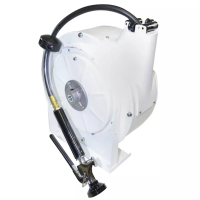Type 1051 & 1052 Styles H & J
11
Figure 7. Actuator Housing Construction Styles
and Mounting Positions
43A6505-A
A1578-3/IL
5. For an actuator with an H mounting adaptation and
a 7/8 through 1-1/2 inch (22.2 through 38.1 mm) out-
put shaft, slide the actuator (with the user-provided
mounting bracket attached) into the user-provided
coupling on the operated shaft. Then, secure the ac-
tuator to the operated equipment in the desired mount-
ing position with the appropriate fasteners, such as
mounting cap screws. See figures 4 and 5 for output
shaft dimensions.
6. For an actuator with an H mounting adaptation and
a 2-inch (50.8 mm) output shaft (key 87, figure 12),
note that the valve shaft coupling (key 90, figure 12) is
furnished with two keyways lettered A and B as shown
in figure 8 (letters C and D on the coupling are not
used and can be disregarded). Align the appropriate
keyway with the keyway in the operated equipment
shaft. Then, install the woodruff key (key 91, not
shown in figure 12) in the shaft keyseat, and slide the
coupling onto the shaft using the appropriate coupling
keyway (see table 5 and figure 8). It is helpful to apply
a light coat of grease to the inside of the coupling be-
fore sliding it onto the shaft. Secure the actuator (user-
provided mounting bracket) to the operated equipment
in the desired mounting position with the appropriate
fasteners, such as mounting cap screws.
7. Follow the instructions given in the Adjustment sec-
tion for turnbuckle adjustment before proceeding to the
loading connection portion of this section.
Loading Connection
1. Connect the loading pressure piping to the pres-
sure connection in the top of the diaphragm casing.
For size 30 through 60 actuators, run either 1/4-inch
pipe or 3/8-inch tubing between the 1/4-inch pressure
connection and the positioner or automatic controller.
For size 70 actuators, run either pipe or tubing be-
tween the pressure connection and the positioner or
automatic controller. If necessary, remove the 1/4-inch
bushing in the pressure connection to increase con-
nection size.
2. Keep the length of pipe or tubing as short as pos-
sible to avoid transmission lag in the control signal. If
an accessory (such as a volume booster or a position-
er) is used, be sure that the accessory is properly con-
nected to the actuator. If a positioner is part of the as-
sembly, the pressure connection to the actuator will
normally be made at the factory.
3. When the actuator is completely installed and con-
nected to the instrument, check for correct action (air-
to-open or air-to-close) to match the controlling instru-
ment. For successful operation, the actuator stem and
operating shaft must move freely in response to the
loading pressure change on the diaphragm.
Adjustment
WARNING
Avoid personal injury or damage to
property from sudden release of pro-
cess fluid. Before starting adjustment:
D Isolate the valve or other operated
equipment from the process,
D Release process pressure, and
D Vent the actuator loading pressure.
Type 1051 and 1052 Turnbuckle
Adjustment
Correct Turnbuckle adjustment ensures that the valve
body or other operated equipment is correctly closed
when the actuator is against its travel stops. The turn-
buckle adjustment is the only adjustment necessary on
the Type 1051 actuator. Key numbers used in this pro-
cedure are shown in figure 10 for Type 1051 actuators
and in figure 11 for Type 1052 actuators.

